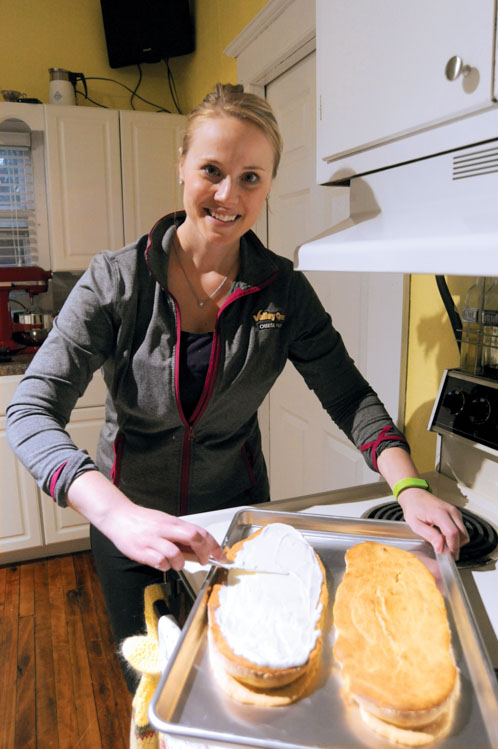The Gift of South Dakota
Subscriptions to South Dakota Magazine make great gifts!
Subscribe today — 1 year (6 issues) is just $29!
A Time-Traveled Treat
 |
| Ashley Frerichs brought her family's kringle tradition from North Dakota. She and her husband, Jason, live on a farm near Wilmot with their daughter, Elizabeth. |
When Ashley Vangsness, of Kindred, North Dakota, fell in love with Jason Frerichs, she knew he wasn’t going to leave his South Dakota farm. So after they married she packed up her clothes and keepsakes and moved to South Dakota. She also brought her mom’s Swedish kringle recipe.
Kringle, it seems, has a tradition of traveling from place to place. In fact, the Scandinavian treat might be one of the best traveled delicacies in the world. Although often considered to be a Danish creation that spread throughout Scandinavia, kringle’s origins can be traced back to a baker’s mistake in Paris 375 years ago.
A French baking apprentice named Claudius Gelee forgot to add butter to his bread dough. He decided to layer the butter into the dough later, and the result was a light and flaky pastry.
In 1622, Gelee opened his own cafe to serve his newfound pastry, which the French began calling “a thousand leaves.” He next introduced the dough in Florence, Italy, where the technique was copied by Italian bakers, who called it “folded pastry.” The Italians took the recipe to Austria, where it was again a success. Austrian bakers called the pastry “wienerbrød,” which means Viennese bread.
The recipe kept traveling. In 1850, a baker’s strike in Denmark caused an influx of Austrian bakers. They brought wienerbrød, which spread throughout Scandinavia, including Sweden.
Kringle is an Old Norse word meaning circle. Depending on local traditions, it is shaped into a pretzel, oval or circle. And can be either sweet or salty. The base is a variation of wienerbrød; sometimes several variations have been passed down in the same family.
Frerichs learned how to make her family’s kringle, a sweet recipe with almond filling and frosting, from her mother in North Dakota. “I started quite young, helping add the ingredients and slowly progressed to making it on my own. Most often, we made it for Christmas or special occasions throughout the year,” she says.
Last year, Frerichs made the treat as a fun way to announce her pregnancy to co-workers at Valley Queen Cheese in Milbank, decorating the plate with pink and blue almond frosting (since they didn’t know the baby’s sex). Since then, Ashley and Jason have welcomed a baby girl, Elizabeth. Ashley already plans on teaching her the family’s kringle tradition.
“Baking foods related to our heritage is important because it is tied to who you are as a person,” she says. “For me, Swedish kringle represents special memories, including baking with my mom and sister, along with enjoying a delicious treat. It is a way to bring home a little closer.”
Swedish Kringle
Ingredients
Crust:
1 cup flour
1/2 cup butter, softened
1 tablespoon water
Topping:
1 cup water
1/2 cup butter
1 cup (rounded) flour
3 eggs
1/2 teaspoon almond flavoring
Frosting:
1 cup powdered sugar
1/2 cup butter, melted
1/2 teaspoon almond flavoring
cream as needed
Directions
Crust: Combine all ingredients with pastry blender. Pat two long strips, 3 inches wide, on a cookie sheet.
Topping: Heat together water and butter. When butter is melted, add flour all at once; immediately remove from heat. Stir until smooth. Add eggs one at a time, beating well after each addition. Stir in flavoring. Spread onto the unbaked crusts. Bake 45 minutes to 1 hour at 350 degrees.
Frosting: Combine powdered sugar and batter. Blend in almond flavoring. Add enough cream to make a good spreading consistency. Frost kringle while slightly warm.
Editor’s Note: This story is revised from the May/June 2018 issue of South Dakota Magazine. To order a copy or to subscribe, call (800) 456-5117.




Comments